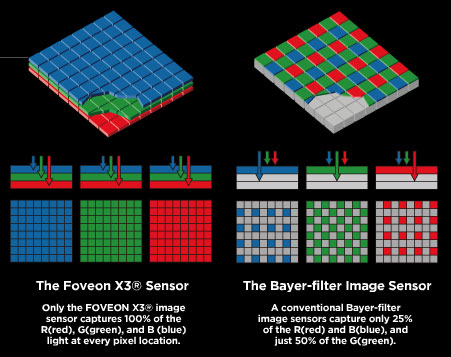Lens used was a X35 wide angle lens (f=35mm) in both cases (infinity mount conversion done for the Nikon, M42 version with adaptor for the Sigma), shot at ISO200. [In all cases please ignore the vignetting of the corners, this was caused by the experimental filter mount I used, which could be done much better to avoid that effect]
This (blurry) result came out of the Sigma SD-14 after 30 sec exposure and f4 used:

It is pretty obvious that only the blue channel of that stacked FOVEON chip responds to UV radiation (as the theory also says, since that chip does not use any dyes to filter, just the effect that silicon filters out shorter wavelengths the deeper light (UV, VIS, IR radiation) penetrates that silicon chip. (c) photoscala.de

That second image shows the result straight out of the Nikon D70 camera:

And NO, this is NOT infrared (IR), just because it is red! I checked with my spectrometer carefully that no IR passes. The color is caused by the fact that at these short UV wavelengths (nearly) only the red channel of that Nikon D70 CCD sensor has some useful UV response (maybe due to visible fluorescence of that red filter dye of the Bayesian filter used when expsosed to UV radiation)
Cameras + exposure used:
1) mod. Nikon D70 (quartz glass filter >270nm) @ ISO200, 30sec, f4
2) Sigma SD-14 w/o int. filter @ISO200, 30sec, f8
It gets pretty obvious, that the mod. Nikon D70 has the much higher UV sensitivity of ca 2EV @330nm. I can only guess that the higher sharpness is due to f8 used and since the UV-infinity converted Noflexar 35mm version was used and not the off the shelf M42 version as for the SD-14. The Nikon image has been adapted to the color of the Sigma, but has pretty much red and a little bit blue channel response. The Sigma only gives some monochromatic blue channel response at much less sensitivity.
So in short the findings:
- Sigma SD-14 w/o internal filter is about 2 stops less sensitive than a mod. Nikon D70
- Sigma SD-14 only records UV in the blue channel, also down to about 320-330nm
- Nikon mod. D70/D70s is about 2 stops more sensitive than a Sigma SD-14
- Nikon mod. D70/D70s may be used down to ca. 320nm, but with much less sensitivity than 350-400nm
- The X35 lens may be used succesfully down to 320nm
Some remark here: This has been done since I get many questions about how far a modern DSLR may be able to record UV. Although it has been proven experimentally now that there is some response, in terms of using that 300-350nm band I would consider that as not being much useful since it does not reveal much different information (at least from what I know today). Normal UV photography using the 2" Baader U-filter obviously records mainly in the 350-400nm band due to the steeply decreasing sensitivity of the camera chip with shorter wavelengths and this with 2-4sec exposure time at ISO200-400, f8-f11 for an unmodified Nikon D70/D70s i.e. 8-10 stops below a normal visual light shot (and 1-2 stops faster for UV using a modified D70 with clear quartz glass window) which is in a real outside situation anyway nearly too long. If you have ever tried to shoot a flower with a bee on it in UV, you know what I'm talking about!
Stay tuned, more will follow on that fascinating subject...
More info on this very interesting field may be found on my site http://www.pbase.com/kds315/uv_photos
